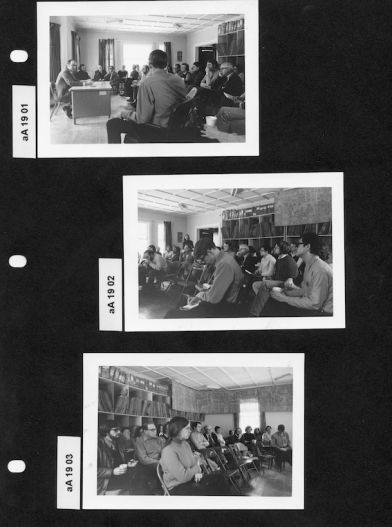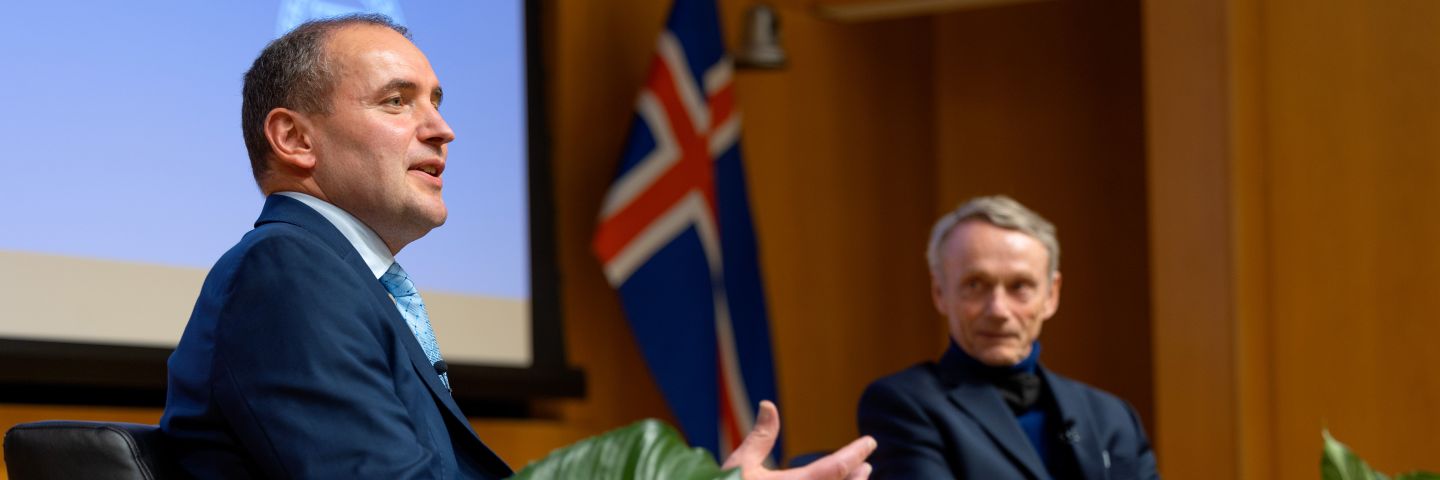From Luncheon Lectures to the Brown Bag to the Gatty Lecture Series, 1950-2021

By Thak Chaloemtiarana, professor, Asian literature, religion, and culture; and Asian studies
The Cornell Southeast Asia Program (SEAP) was founded by Professor Lauristan Sharp in 1950 with Professor George Kahin as its Executive Director. To help this new enterprise form an emerging field of study when there were few published texts or research, it was decided that prominent figures, be they scholars or government officials who know Southeast Asia, should be invited to campus to give lectures, seminars, and to meet with the few pioneering graduate students affiliated with the program.
In his 1952 annual report, Professor Kahin explains: A special effort was made during the course of 1952 to bring to Cornell at fairly regular intervals visiting lecturers possessing a particular knowledge of one or more of the various Southeast Asian countries. Some of these people met with scheduled seminars, while special meetings of students and staff in the Program were arranged to be addressed by others. In addition, our students were encouraged to meet with these people informally for talks in those cases where these visitors were here for more than a day.
In the very first few years of SEAP’s existence, many famous and well-known individuals came to give lectures at Cornell. These included Professor Paul Mus, US Ambassador to Thailand Edwin Stanton, Luang Bisuddhi Suriyabongs, Professor Pe Nuyent (Chairman of the Department of Political Sciences, the University of Rangoon), Sanya Dhammasak, Prince Piya Rangsit, Margaret Mead, Indonesian Ambassador to the UN Ali Sastroamidjojo, Lieutenant Governor of the Netherlands Indies H.J.van Mook, and Mom Luang Tooi Xoomsai. Amazingly, in addition to the eight Indonesian government officials who stayed at Cornell for a whole month, seventeen visitors gave lectures in 1952. In 1953, the practice of bringing notable lecturers to campus continued, among those who came to Cornell was Ngo Dinh Diem. He returned to South Vietnam the following year to become prime minister under Emperor Bao Dai.
Thus, SEAP was one of first—if not the first—to institutionalize a lecture series at Cornell in order to construct a new field of study and to educate its graduate students about Southeast Asia.
1950-1970
Both Professor Stanley O’Connor (SEAP 1959-1965) and Professor Charles Keyes (SEAP 1959-1965) of the University of Washington confirmed that the Brown Bag lectures were already in existence when they arrived. With the help of Emily Donald who did most of the legwork in finding data of the early years, I can now pronounce that the Brown Bag luncheon lecture program was established on February 26, 1959. Eight graduate students—Jack Carroll, Ngoc Thu Phan, Idrus Djajadiningrat, Herbert Feith, Jasper Ingersoll, Joo D. Khoo, Donald Pond, and David Wurfel—sent a note to members of the Southeast Asia Program announcing that regular meetings would be held at 102 West Avenue every other Thursday for talks during the lunch hour. Soon, however, the lectures became weekly events. The note gave the following reasons for establishing the regular lunch hour talks:
…to enable members to know each other better and to share more fully our individual experiences and interests in Southeast Asia. This would also provide a forum for speakers whom many of us have otherwise no opportunity to hear: visitors to Ithaca, Cornellians recently back from Asia, and so on.
The suggestion was that faculty and students would meet to eat lunch by bringing their own sandwiches in typical “brown (paper) bags.” SEAP would provide coffee. As an aside, by the time I arrived ten years later in 1968, in addition to coffee, there were also cookies! The Brown Bag lecture series retained its name even after free lunches were provided when I became director of SEAP in 1998. From pizza, coffee, soda, and cookies, the graduate student committees have, over time, opted for more healthy victuals and diversity of cuisines. The Brown Bag (BB) lecture series was renamed the endowed Ronald and Jeanette Gatty lecture series in 2014. SEAP’s Thursday luncheon lecture series is the only one on campus that provides free lunch for its audience.
The first BB lecture meeting was held on Thursday, March 5th at 12:15 p.m. at 102 West Avenue. The Thursday lunch hour thus became a tradition since 1959. Another important feature of the lecture series is that it is managed by a graduate student committee chaired or co-chaired by one or two of its members. In this way, students are involved in the shaping of the field by identifying speakers whose works or knowledge were either foundational, exciting, emerging, or trending. The leadership and participation of all students at the lectures and following dinner meeting also facilitated their entry into the international scholarly network beyond the SEAP community. Faculty involvement in selecting speakers has been mainly in advisory roles.
102 West Avenue is the address of the Modern Indonesia Project building where Professors Kahin, Anderson, graduate students writing dissertations (or married with children), and visiting fellows had offices. That building was a rundown (at one time condemned) former fraternity house. It was finally declared unfit for habitation, demolished, and made into a parking lot. It was the predecessor to the Kahin Center.
102 West is well-known to the early scholars of Southeast Asia because many foundational dissertations (later published as books) written there gave credit to that building. The slanting floors, rickety stairs, loose bannisters, and drafty windows surprised visitors who were amazed that this famous building that produced so much early scholarship on Southeast Asia was so dilapidated and unworthy of its reputation. However, Professor Kahin famously declared that scholarly productivity is inversely related to the underwhelming magnificence of 102 West.[i]
Professor Stan O’Connor sent me an email that succinctly summarized the importance of the early BB lectures. Professor O’Connor writes:
People were widely scattered and eager to find people with similar obsessions and experience. Several seemed quite odd, but very lively…including many European scholars and some public officials from Southeast Asia… All this had a wonderful feeling of beginnings and discovery… Almost everyone in this small community came to 102 West Avenue adding excitement to the jumble and provisionality of the building itself. These were high energy occasions. Everyone showed up for what was often quite exciting…you did have the feeling of something into being. The talks were exploratory, searching, and consequential. There was limited reading of research papers or reflection on methodological anxieties. The Brown Bags did what they were intended to do: build an intellectual community.
When I arrived in 1968, the Brown Bag lectures at 102 West were unrivalled on campus as a “must attend” and “standing-room only” events. Because of the US involvement in Southeast Asia and the anti-Vietnam War movement, interest in the region peaked from the mid-1960s until the end of the 1970s. The lectures and those in attendance—graduate students from SEAP and beyond, and almost all SEAP faculty members—were eager to witness the energy, excitement, and discovery of new knowledge that began to shape Southeast Asian Studies as a viable field of study, and to learn about a region that was important to US foreign policy. Scholars and government officials from beyond Cornell came to talk about their work and how it was relevant to our common interest. Many of the lectures, if not most, presented raw data and unfolding discoveries. In a sense, those who attended the talks were also participants of the presenter’s journey and experience.
The majority of speakers in the 1960s were professors, both well-established scholars and younger scholars who helped to shape Southeast Asian Studies as a viable field of study. Some of these scholars (now well-known) included Harry Benda, Ruth McVey, J.A.C. Mackie, Nicholas Tarling, Robert O.Tilman, Wang Gung Wu, James Peacock, Bernard Fall, A. Thomas Kirsch, William Klausner, Lucien Hanks, Elizer Ayal, Alexander Griswold, Josef Silverstein, David Wyatt, Robert Pringle, John Smail, Frederick Bunnell, Wilhelm Solheim, Stanley Tambiah, David Wilson, Herbert Philips, Ben Anderson, David Marr, Hans Dieter Evers, and James Siegel.
The tradition of enhancing the understanding of Southeast Asia also continued into the 1960s with talks given by prominent personalities and US officials who were involved in the affairs of the region. The names of speakers who were not associated with universities included, for example, Colonel Ngoc Thao Pham (Armed Forces of the Republic of Vietnam); Van Dinh Tran (Vietnam Embassy); Francis Underhill (U.S. Army War College); Sukich Nimmanhaemin (Thai Ambassador to the U.S.); Colonel George Benson (U.S. Army Attache, Djakarta); Anthony Eden (Earl of Eden and former UK prime minister who spoke about Vietnam in the international situation); Mohamad Roem (former prime minister of Indonesia); Paul Sitthi-Amnuay (Vice President, Bangkok Bank, NY); Gunnar Myrdal (author of Asian Drama); Mohammad Hatta (former prime minister and VP of Indonesia); General Carlos Romulo (former Foreign Secretary and President of the University of the Philippines); Soejatmoko (Indonesian Ambassador to the U.S.), Douglas Pike (United States Information Service), and C.V. Devan Nair (Malaysian MP and future President of Singapore).

